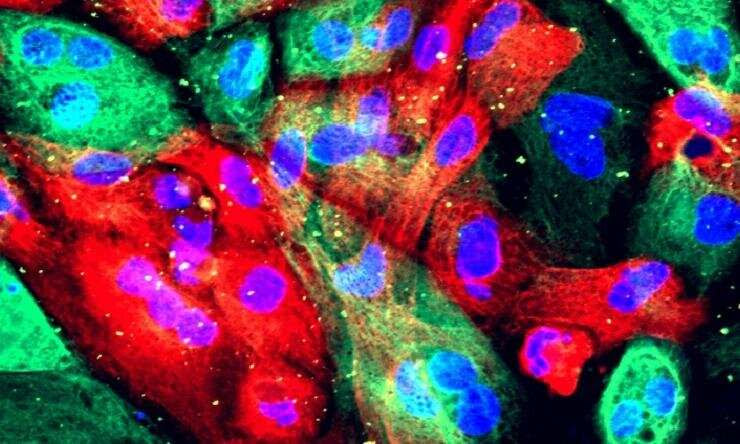by Memorial Sloan Kettering Cancer Center

Prostate cancer cells. Credit: NIH Image Gallery
A previously unknown subtype of hormone-resistant prostate cancer accounts for about 30% of all cases, according to a new study from a team of scientists at Memorial Sloan Kettering Cancer Center (MSK) and Weill Cornell Medicine, published May 27, 2022, in the journal Science. The results could pave the way for targeted therapies for people with this subtype of prostate cancer.
Prior to this recent work, which was led by MSK physician-scientist and Human Oncology and Pathogenesis Program member Yu Chen, only two prostate cancer subtypes had been described: androgen dependent and neuroendocrine. Dr. Chen’s team calls the newly characterized third type stem cell-like (SCL), because some of the genes that are turned on in the cells are reminiscent of those in stem cells.
To make their discovery, Dr. Chen and his team examined 40 different patient-derived models of prostate cancer obtained from people with cancer treated at MSK and Weill Cornell.
“We didn’t know whether we were going to find additional subtypes,” Dr. Chen says. “This is a field that’s been studied for many years, by many investigators. So we were happy and surprised to find that there’s this fairly large group of patients with tumors that haven’t been characterized.”
Innovative technologies enable new insights
One reason the subtype may have alluded researchers is that there aren’t enough good laboratory models for studying this type of cancer.
“Prostate cancer is uniquely difficult to propagate in the lab,” Dr. Chen explains. “Whereas there are hundreds of cell lines of melanoma and lung cancer, there’s only three or four prostate cancer cell lines that are useful.”
To circumvent this problem, the team turned to a new technology called organoids. The organ-like structures are grown in the lab from pieces of a patient’s tumor. They are a kind of “avatar” of patient’s tumor and can be used to study its genetics and biochemistry.
In addition, the team made use of patient-derived xenografts—tumors removed from a patient and grown in a mouse—for a total of 40 different patient-derived models of prostate cancer.
With these patient-derived organoids in hand, they could then determine which genes are turned on or off in the cells. This information was used by the scientists to determine that a new subtype of prostate cancer exists.
Next, they looked to see if the SCL subtype was apparent in a biobank of 366 prostate cancer tumors. It was. In fact, it was the second most prevalent group, after the androgen-sensitive type.
Knowing the molecular drivers of this common subtype of prostate cancer opens the door to approaches that could target these drivers with drugs.
New treatment possibilities
“For the past 80 years, the backbone of treatment for prostate cancer has been hormone-deprivation therapy,” Dr. Chen explains. “That’s because essentially all prostate cancers when they are first diagnosed depend on testosterone signaling.”
“Once patients become resistant to antigen deprivation,” he continues, “it becomes a universally lethal disease.”
This is where the new findings could help improve treatment options. The scientists found that there are experimental drugs currently being tested in humans that can block the growth of the SCL subtype in laboratory and animal models. They are currently working with several companies to establish a clinical trial of their drugs for people with this subtype of prostate cancer.

Leave a Reply